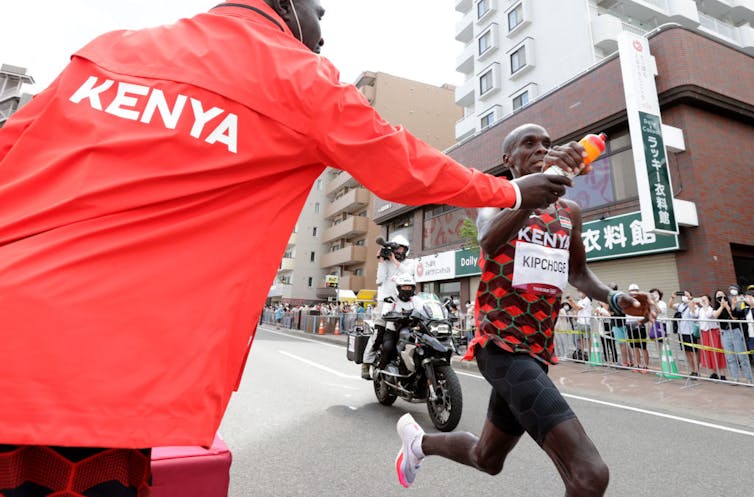
Photo by Yasuyuki Kiriake-Pool/Getty Images
Wycliffe W. Njororai Simiyu, University of Texas at Tyler
As a small developing nation, Kenya has consistently punched above its weight on the international sports arena, more so in athletics. This is reflected perfectly in the fact that 93% of Kenya’s 114 Olympic medals won between 1964 and 2021 are in track and field while the remaining seven came from boxing.
My closer examination of Kenya’s historical performances further reveals the country’s strengths to be in middle and distance events. These range from 800 metres around the track to the marathon. Of the 107 medals won in track and field, 101 (94.39%) were in middle and distance events – split between women (27.10%) and men (72.90%).
A number of factors are attributed to this consistent top-level performance. First is the early introduction of the sport in numerous settings going back to the colonial period. New talent was nurtured in regular school-based competitions running from local to national level.
Second is the mass recruitment of promising athletes into the uniformed forces. Here, sustained training under near-professional settings improved performances and stimulated competition for top places. Third, most athletes are born, raised and train at high altitude, which enhances their physiological efficiency.
Moreover, since the 1980s, the professionalisation of track and field and especially distance running opened doors for more talents to emerge and pursue earning a living from their running ability.
Kenya’s dominance however has historically been tested by Ethiopians. More recently, the challenge comes from the emergence of Uganda, cementing the place of East Africa as the powerhouse of distance running. Tokyo 2020 revealed the shape of the new challenge. It is the threat of talented fellow Kenyans as well as Somalis, Sudanese and Ethiopians who have switched allegiance in droves to better resourced countries outside Africa.
For example, Sifan Hassan, the Ethiopian-born runner who moved to the Netherlands as a refugee, won two gold medals in the Olympic 5,000m and 10,000m as well as bronze in the 1,500m race. Abdi Nageeye, a Somali, ran for the Netherlands and won silver in marathon.
He also encouraged another Somali, Bashir Abdi, running for Belgium, to win a bronze at the expense of Lawrence Cherono of Kenya. Yet another Somali, Mohammed Ahmed, won silver for Canada in the 5,000m men’s race. Paul Chelimo, one of five Kenyans in team USA, won a bronze in 5,000m ahead of Nicholas Kimeli of Kenya.
In Tokyo, these migrants denied their former African compatriots medals in men’s marathon, men’s 5,000m, women’s 5,000m, 10,000m, 1,500m and women’s 800m.
This no doubt contributed to a decline in medals won by Kenya, and even Ethiopia. This trend is likely to continue as the second generation of immigrants, such as Athing Mu of the USA, is going to hurt Kenya’s chances for more medals.
Tokyo 2020 takeaways
Tokyo, the venue of the 2020 Olympic Games, holds symbolic meaning for Kenya as the city where its long tradition of winning medals started. That was in 1964 when Wilson Kiprugut won a bronze in the 800m race. This time around, Kenya men won a gold and silver over that distance. The gold was the fourth in a row at the Olympics.
However, it was not all plain sailing. One of the most painful moments of the 2020 Olympics was the loss of the steeplechase title for men. Kenya won gold medals in 1968, 1972, 1984, 1988, 1992, 1996, 2004, 2008, 2012 and 2016.
For a country that dominates distance running, missing out on medals at this signature distance event is worth evaluating by Athletics Kenya. The team selection and preparation has to be better and the tactics have to be right for the moment.
But as the Tokyo Olympics showed, Uganda is gradually adopting the Kenyan playbook in running as they scooped two gold medals, one silver and one bronze in women’s steeplechase, 5,000m men and 10,000m men. What benefited Uganda was the dramatic decline of Ethiopia too as the latter normally win medals in 5,000m and 10,000m men’s events that the former won in this time around.
The dual threat of migrant athletes from the East African region and the emergence of Uganda sends a powerful message that Kenya needs to look beyond its core strengths moving forward. The emergence of new sprint hero Victor Omanyala is a reminder that Kenya has its work cut out to invest more resources in short races.
Conclusion
Kenya’s 19th ranking at the Tokyo Olympic Games with 10 medals (four gold, four silver and two bronze) was once again the pride of Africa. It ranked third behind the USA and Italy in track and field.
However, the drop in medals, the emergence of Uganda’s middle and distance runners as well as the continued rivalry posed by East African migrant athletes should challenge the Kenyan sports leaders to push for more investment of resources in other areas where there is potential to win Olympic medals. This has to be a deliberate effort as the 33rd Olympiad in Paris, France is only three years away.![]()
Wycliffe W. Njororai Simiyu, Professor, Health and Kinesiology, University of Texas at Tyler
This article is republished from The Conversation under a Creative Commons license. Read the original article.


